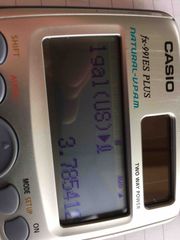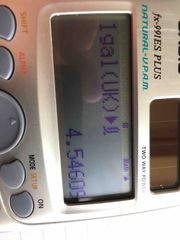![]()
![]()
![]()
Use LEFT and RIGHT arrow keys to navigate between flashcards;
Use UP and DOWN arrow keys to flip the card;
H to show hint;
A reads text to speech;
31 Cards in this Set
- Front
- Back
- 3rd side (hint)
|
Quadrantal rule |
odd, odd + 500 ft, even, even + 500ft |
|
|
|
Safety altitude - highest fixed object within 5 NM is ground below 500 ft |
Assume ground 499 ft + assumed obstacle 299 ft = 798 ft Add 1000 ft Round up to nearest 100 ft |
|
|
|
Safety altitude - highest fixed object within 5 NM is ground 500 ft or higher.
|
Add assumed obstacle 299 ft Add 1000 ft Round up to nearest 100 ft |
|
|
|
Safety altitude - highest fixed object within 5 NM is obstacle with given height. |
Obstacle elevation Add 1000 ft Round up to nearest 100 ft |
|
|
|
Semicircular Rule VFR/IFR cruising level system is based on magnetic heading or magnetic track? |
Magnetic track. |
|
|
|
Position report. |
'G-BNVE, PA28, overhead Daventry VOR (10)04, altitude 3000 ft on 1013, estimate Coventry at (10)18' |
|
|
|
ISOL |
ISOLATED max spatial coverage < 25%, features can be avoided |
|
|
|
OCNL |
OCCASIONAL max spatial coverage 25% to 50%, features can be avoided |
|
|
|
FRQ |
FREQUENT max spatial coverage > 50%, convective types only, DIFFICULT to avoid |
|
|
|
WDSPR |
WIDESPREAD max spatial coverage > 50%, convective AND non-convective types, DIFFICULT to avoid |
|
|
|
What’s the formula for time [min] if distance [NM] and GS [kts] are known? |
time [min] = ( distance [NM] / GS [kt] ) * 60 |
Tip: if approximating in head, multiply distance by 60 first, then divide e.g.: 10 NM * 60 = 600 600 / 105 [kt] = approx. 6 [min] |
|
|
QDR |
is MAGNETIC bearing of the AIRCRAFT from the station |
e.g. VOR radial |
|
|
QTE |
is TRUE bearing of the AIRCRAFT from the station |
|
|
|
QDM |
is MAGNETIC bearing of the STATION from the aircraft |
e.g. magnetic heading to fly TO the VOR |
|
|
QUJ |
is TRUE bearing of the STATION from the aircraft |
|
|
|
VDF bearing accuracy CLASS A? |
+/- 2 degrees |
|
|
|
VDF bearing accuracy CLASS B? |
+/- 5 degrees |
|
|
|
VDF bearing accuracy CLASS C? |
+/- 10 degrees |
|
|
|
VDF bearing accuracy CLASS D? |
Exceeding +/- 10 degrees |
|
|
|
What’s ASI behaviour on climb when Pitot tube is blocked? |
ASI behaves like ‘altimeter’, speed increases on climb, speed decreases on descend. |
|
|
|
What’s ASI behaviour on descend when Pitot tube is blocked? |
ASI behaves like ‘altimeter’, speed increases on climb, speed decreases on descend. |
|
|
|
What’s ASI behaviour on climb when static vent is blocked? |
During the climb Pitot static pressure is less and decreasing than vent static pressure, the Pitot dynamic pressure is decreased by this difference, ASI underreads. |
|
|
|
What’s ASI behaviour on descend when static vent is blocked? |
During the descend Pitot static pressure is greater than vent static pressure, the Pitot dynamic pressure is increased by this difference, ASI overreads- DANGER! |
|
|
|
ASI over-reads in what TWO scenarios? |
blocked Pitot tube on climb (icing, left Pitot tube cover) blocked static vent on descend (icing) |
|
|
|
If an aircraft is at 2000 ft and the VOR transmitter (VHF) has an elevation of 250 ft, what is the line of sight range in NM? |
range = 1.25 x [ sqrt( height of aircraft ft) + sqrt( elevation of transmitter ft) ] = 76 NM |
|
|
|
Convert 1 NM to meters? |
1NM = 1852 m |
|
|
|
Convert 1000 ft to metres? |
1000 ft = 304.8 m |
|
|
|
Convert 1 US.Gal to litres. |
1 US.Gal is 3.785 412 litres. |

Mnemonic: 1 US.Gal to prawie cztery litry, a 1 Imp.Gal to cztery i pół litra. |
|
|
Convert 1 Imp.Gal to litres. |
1 Imp.Gal is 4.546 09 litres. |

Mnemonic: 1 US.Gal to prawie cztery litry, a 1 Imp.Gal to cztery i pół litra. |
|
|
What is meaning of the abbreviation RAPID, that may be used in a TAF or METAR? |
Rapid change (within next 30 mins). |
|
|
|
What is the meaning of NOSIG? |
No significant change in forecast during the 2 hours following the observation. |
|

